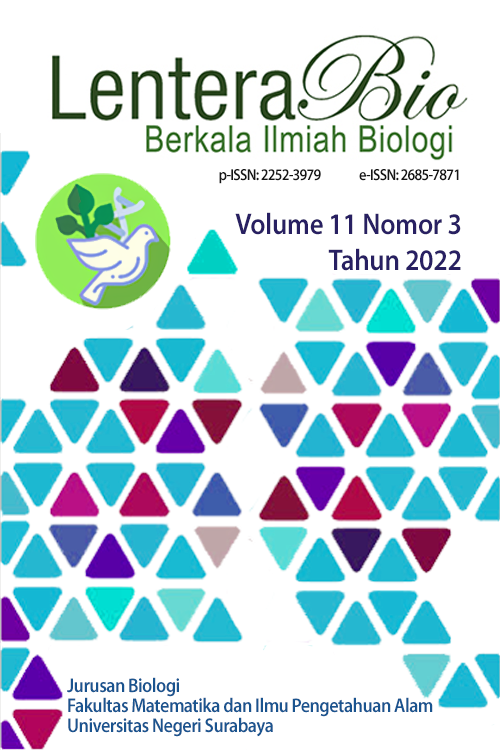Variation in Anatomical and Secretory Structure of Annona Species has Potential as Medicinal Plant
DOI:
https://doi.org/10.26740/lenterabio.v11n3.p575-585Keywords:
genus Annona, medicinal plant, secretory structure, stomata, trichomeAbstract
The Annona plant has a high content of secondary metabolites. Metabolites are removed from the secretory structure of this plant. This study aims to describe the anatomical and secretory structures of the three Annona species that have the potential to produce secondary metabolites. The research was conducted on the leaves of Annona muricata, Annona squamosa and Annona cherimola using paraffin and whole mount methods for transverse and paradermal observation of the preparations. The results of the research on the three Annona species showed the anatomical structures in the form of curved and grooved anticlinal epidermal walls, long sclereid cells, stone cells, parasitic stomata, the highest density in A. muricata (527,34/mm2) and the medium density in A.squamosa (454,89/mm2), the highest density index in A.cherimola (0,137), while trichomes in the form of glandular and non-glandular trichomes were only found in A. muricata and A. cherimola. Secretory structures that have potential as medical for anticancer, antitumour, hypertension, antibacteria, fungal infections and antidepressants were found in the form of essential oil cells in A. muricata species and lithic cells, idioblast cells, secretory spaces in these three Annona species. The secretory structures in thes three Annona species have variations in both cell types and locations.
Downloads
Published
How to Cite
Issue
Section
License
Copyright (c) 2022 LenteraBio : Berkala Ilmiah Biologi

This work is licensed under a Creative Commons Attribution-NonCommercial 4.0 International License.
Hak Cipta (c) LenteraBio: Berkala Ilmiah Biologi
Karya ini dilisensikan di bawah Lisensi Internasional Creative Commons Attribution-NonCommercial 4.0.
Pemberitahuan Hak Cipta.
Hak cipta dari artikel yang diterima untuk diterbitkan akan diberikan kepada jurnal sebagai penerbit jurnal. Hak cipta yang dimaksud meliputi hak untuk menerbitkan artikel dalam berbagai bentuk (termasuk cetak ulang). Jurnal mempertahankan hak penerbitan atas artikel yang diterbitkan.
 Abstract views: 2595
,
Abstract views: 2595
, PDF Downloads: 9645
PDF Downloads: 9645











